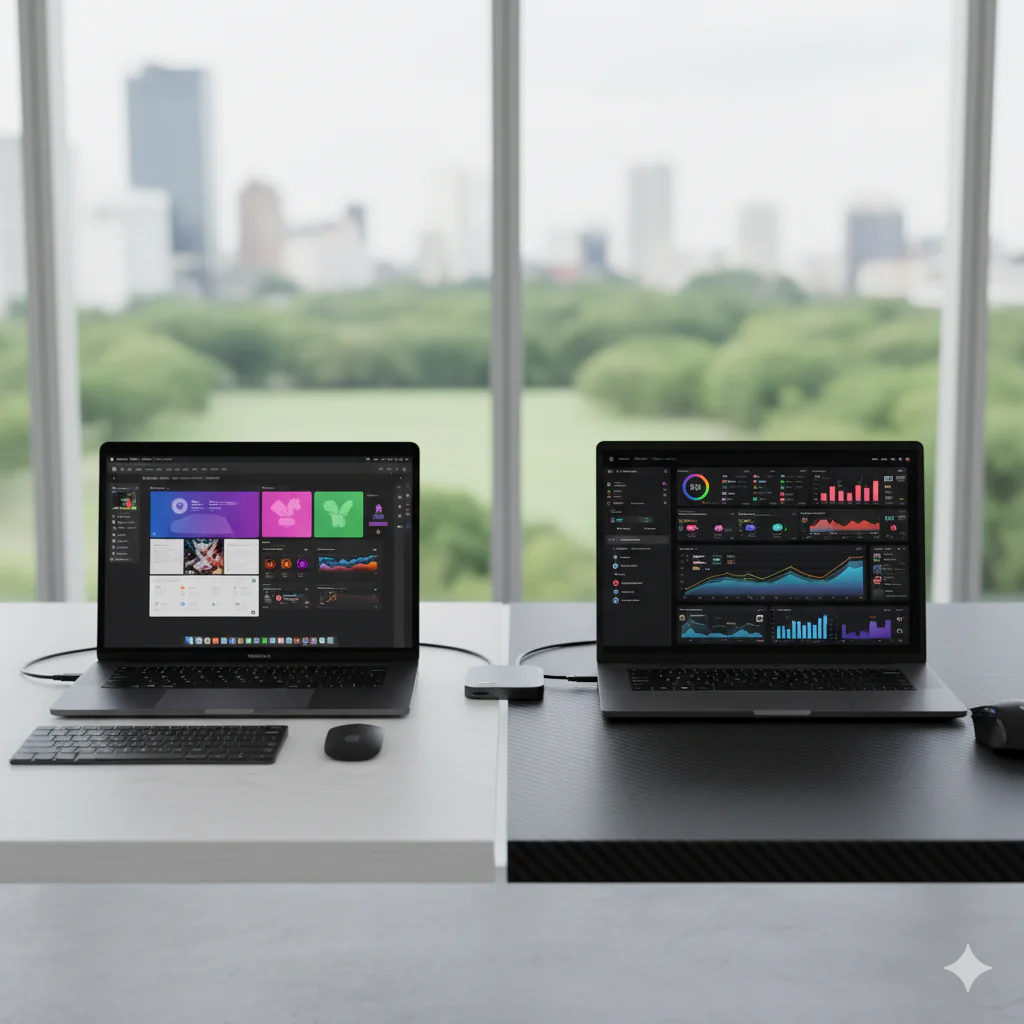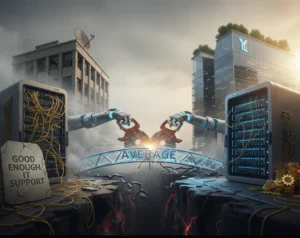✅ What We’ll Cover in This Article – Mac vs PC: Who Wins?
- Why the Mac vs PC debate looks different in marketing
- Where Macs shine — and where PCs still win
- A peek into my own Mac setup as a CMO
- ROI math: time saved vs dollars spent
- Key questions to answer before making the call
Introduction: Why I Care About This Question
I’ll be upfront: I’m a Mac guy.
As CMO of Doceo, I spend my days straddling creative work, analytics, client presentations, and team management. And I run all of it inside Apple’s ecosystem. My Mac, iPhone, and iPad talk to each other constantly. I can brainstorm in Notes, AirDrop visuals into a deck, and join a Teams, or Zoom call without skipping a beat.
That said, I don’t believe Macs are automatically the right answer for every marketing team. PCs still make a lot of sense in the right environments — especially when IT, Finance, and Marketing need to align.
So, who really “wins”? Let’s walk through this from a marketer’s perspective.
How Marketers Actually Use Their Machines
Marketing isn’t one role. It’s a whole stack of different jobs:
- Creative pros editing video, building collateral, and retouching images.
- Digital marketers juggling automation, analytics, and reporting.
- Content teams producing blogs, ebooks, and web updates.
- Event marketers creating decks, signage, and print assets on tight deadlines.
The platform you choose affects everything from campaign launch speed to IT ticket volume. This is why the Mac vs PC question isn’t philosophical — it’s operational.
My Setup: Why I Lean Mac
For context, here’s the machine I live on daily:
- MacBook Pro 16-inch (Nov 2024)
- Apple M4 Max chip
- 64 GB memory
- macOS Tahoe 26.0
This setup is a creative workhorse. I can run Adobe Premiere, Photoshop, Illustrator, and WordPress at the same time, with Teams and Notion humming in the background — and the fans barely kick in.
To match that performance on the PC side, you’d need a workstation-class laptop with a discrete GPU, 64 GB RAM, and active cooling. Even then, battery life and portability wouldn’t compare.
This doesn’t mean every marketer needs a top-end Mac. But it demonstrates how Apple’s vertical integration (hardware + software + silicon) creates real efficiency gains in daily marketing workflows.
Where Macs Shine for Marketing Teams
- Creative horsepower: Adobe Creative Cloud and Final Cut Pro take full advantage of Apple Silicon. Export times drop dramatically compared to older Intel chips.
- Ecosystem advantage: AirDrop, Handoff, and iCloud keep iPhones, iPads, and Macs in sync. For marketers constantly sharing visuals and notes, that continuity removes friction.
- Client-facing perception: Whether we admit it or not, showing up to a pitch with a Mac carries a brand weight that Windows laptops usually don’t.
- Resale value: A three-year-old Mac often sells for 30–40% of its original cost. Comparable PCs tend to resell for a fraction of that.
👉 Doceo Pro Tip: If design and video sit at the core of your marketing, Macs may deliver ROI faster than you expect — but always run the math.
Where PCs Win (and Why Marketing Leaders Should Care)
- Software compatibility: Some marketing automation or analytics tools are Windows-only, creating roadblocks for Mac users.
- IT integration: Most organizations already run Microsoft 365, Active Directory, and Windows servers. PCs align more smoothly with existing security and patching workflows.
- Cost flexibility: PCs range from budget-friendly laptops to high-end workstations, giving Finance options that Apple doesn’t.
- Device management: IT teams usually have established PC management tools. Supporting Macs may require additional licenses and training.
👉 Doceo Pro Tip: Don’t ignore IT friction. A $400 “savings” on hardware can evaporate quickly if support tickets double.
ROI Snapshot: The True Cost of Time Saved
Sticker prices only tell part of the story. The real ROI often comes down to time saved in workflows.
Hypothetical Example:
- Video editor runs 4 projects per week. Each export is 15 minutes faster on a Mac.
- That’s 1 hour per week × 50 weeks = 50 hours per year saved.
- At $50/hour loaded cost, that’s $2,500/year in regained time.
Over three years, that’s $7,500 in productivity gains — far outweighing a $600–$800 Mac premium.
👉 ROI takeaway: Ask not just, “What does this device cost?” but also “What does it help us avoid in wasted hours?”
Mixed Fleets: The Most Realistic Answer
Across the Mid-Atlantic region, I see the same pattern in marketing teams:
- Creative staff on Macs for design, video, and client-facing roles.
- Ops and analytics staff on PCs for compatibility and reporting.
- Executives picking what fits their workstyle, then leaning on IT for integration.
This hybrid model works well, but it requires upfront planning for licensing, security policies, and cost reporting.
Key Questions to Ask Before You Decide
- Which of our marketing tools are Windows-only?
- Which roles benefit most from Apple’s ecosystem (Mac + iPhone + iPad)?
- How will IT secure and support both macOS and Windows fleets?
- Does resale value factor into Finance’s TCO model?
- What’s the productivity cost of slower workflows if we choose one platform over the other?
FAQ
Do Macs really outperform PCs for creative work?
Yes, especially on Apple Silicon chips. But GPU and RAM matter as much as brand.
Are Macs more secure than PCs?
Not by default. Security depends more on MFA (multi-factor authentication), patching, and EDR (endpoint detection and response).
Is it harder to manage a mixed fleet?
Slightly, but modern MDM tools let IT enforce consistent policies across both platforms.
Do clients notice if creative staff use Macs?
In creative industries, yes. For analytics-heavy roles, it rarely makes a difference.
When should we refresh devices?
Most teams replace every 3–5 years, or sooner if repair costs exceed device value .
Conclusion: My Honest Take as a CMO
From where I sit, Macs are more than worth it for creative marketing roles. My M4 Max MacBook Pro isn’t just a preference — it’s a productivity multiplier. Campaigns move faster, collaboration feels smoother, and client perception benefits too.
That said, PCs aren’t going away. They win on compatibility, cost flexibility, and IT alignment.
The best path forward? Right-sizing by role. Give creatives the tools that accelerate output. Give ops and data staff the stability of PCs. Standardize where you can, flex where you must.
👋 Have questions or want to talk through your options? We’re here to help. Talk to a Doceo IT Advisor today: Let's Talk





